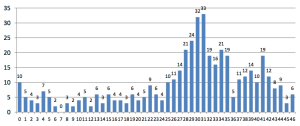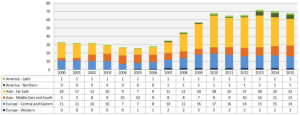Peter Lobner
In June 2016, the International Atomic Energy Agency (IAEA) published a report by the Director General entitled, “Nuclear Technology Review 2016,” which highlights notable developments in 2015 in the following segments of the worldwide nuclear industry.
- Power applications
- Generation
- Fuel cycle
- Safety
- Advanced fission
- Gen III large water cooled reactors
- Fast reactors
- Gas-cooled reactors
- Small & medium size reactors (SMRs)
- Gen IV advanced reactors
- Fusion
- Accelerator and research reactor applications
- Other applications
- Emerging industrial applications of radiation technologies
- Advances in medical imaging technology
- Use of radiation in connection with managing mosquito disease vectors
- Use of isotopic techniques for soil management
The following chart from the IAEA report shows the age distribution (years of operation) of the worldwide fleet of 441 operating power reactors. The median age of this fleet is about 26 years, and you can see a bow wave of aging nuclear power plants, followed by far fewer younger plants already in operation.
The following chart from the IAEA report shows the number of new plants under construction by region. As of the end of 2015, a total of 68 nuclear power plants were in various stages of their decade-long construction cycles. This chart clearly shows that Western Europe and the Americas are minor players in the construction of new reactors. Most of the new power reactor construction is occurring in Asia and Central / Eastern Europe.
IAEA reported that, in 2015, worldwide nuclear power generation reached 381.7 GWe. Projections for the future growth of nuclear power generation thru 2050 were given for two cases:
- Low case: In this case, new plants just make up for the generating capacity lost from retiring plants. Projected 2050 worldwide generation: 371 GWe.
- High case: This is a much more optimistic case, yielding about 964 GWe worldwide generation by 2050.
IAEA noted that, “The 21st Conference of the Parties to the United Nations Framework Convention on Climate Change (COP21) resulted in the Paris Agreement that neither identifies nor excludes any particular form of energy.” The Paris Agreement does not discriminate against nuclear power as a means for reaching lower carbon emission goals. In contrast, the U.S. Environmental Protection Agency’s (EPA) euphemistically named “Clean Power Plan” fails to give appropriate credit to nuclear power as a means for utilities and states to reduce the carbon emissions from their portfolio of power plants. (See my 3 July 2015 and 27 November 2015 posts for more on CPP).
IAEA further noted the contribution of nuclear power to meeting lower carbon emission goals:
“Nuclear power has significantly contributed to climate change mitigation by avoiding nearly 2 billion tonnes (metric tons) of carbon dioxide per year. For nuclear power to help limit global warming to 2o C by 2100, its capacity would need to match the high projection to avoid nearly 6.5 billion tonnes of greenhouse gas emissions by 2050.”
Among the small and medium size reactors (SMRs), IAEA noted that the following three were under construction in 2015: Argentina’s CAREM-25, Russia’s KLT-40S, and China’s HTR-PM. Another dozen SMRs were considered to be in the advanced design stage and potentially deployable in the near-term.
IAEA maintains its Advanced Reactors Information System (ARIS), as I reported in my 13 February 2015 post. This is a very comprehensive source of information on all types of advanced reactors. You can directly access ARIS at the following link:
The “Nuclear Technology Review 2016” provides a useful overview of worldwide nuclear fuel cycle activities:
- Worldwide uranium mining in more than 15 countries produced about 57,000 tonnes of Uranium (U) in 2015. Kazakhstan is the leading producer, followed by Canada.
- Worldwide annual capacity for conversion of U to UF6 was about 60,000 tonnes in 2015, approximately matching annual demand. Canada, China, France, Russia, UK and U.S. operate conversion facilities.
- Worldwide annual enriched light water reactor (LWR) fuel fabrication capacity is about 13,500 tonnes vs. an annual demand of about 7,000 tonnes. In addition, the fuel fabrication capacity for natural uranium fuel for pressurized heavy water reactors (PHWRs) is about 4,000 tonnes vs. a demand of 3,000 tonnes. Thirteen nations produce LWR fuel, and five produce PHWR fuel.
- Spent fuel reprocessing is being carried out in 5 nations: China, France, India, Russia and UK; with France and Russia offering reprocessing services to international customers. France and UK have the greatest capacity, reprocessing about 1,000 t HM/year.
- IAEA reported that, “by the end of 2015, (worldwide) spent fuel in storage amounted to around 266,000 tonnes of heavy metal (t HM) and is accumulating at a rate of around 7,000 t HM/year.
- Several nations are planning or developing their own geologic disposal facilities for spent nuclear fuel
There’s a lot more information in the IAEA report, including information on fusion, accelerators, research reactors, and industrial and medical applications of nuclear technologies. You can download this IAEA report at the following link:
https://www.iaea.org/About/Policy/GC/GC60/GC60InfDocuments/English/gc60inf-2_en.pdf

